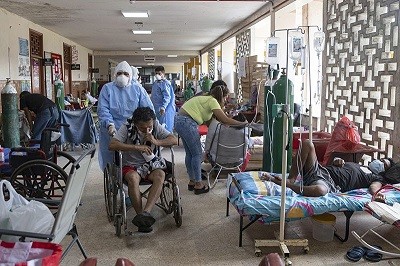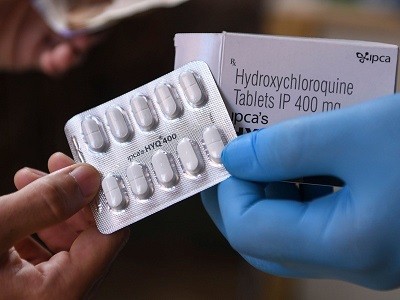Nobody understands anything as evidenced by this site. People are willing to discount mass observational evidence from now hundreds of doctors using it - and consider that "anecdotal" but are looking for some statistical darling study iinstead (that could only be funded by pharma but wont be funded by pharma)
I posted a careful meta-analysis of bias in ivermectin trials: https://www.medrxiv.org/conten…101/2021.08.19.21262304v1
Bias as a source of inconsistency in ivermectin trials for COVID-19: A systematic review
Background and purpose
The objective of this systematic review is to summarize the effects of ivermectin for the
prevention and treatment of patients with COVID-19 and to assess inconsistencies in results
from individual studies with focus on risk of bias due to methodological limitations.
Evidence review
We searched the L.OVE platform through July 6, 2021 and included randomized trials (RCTs)
comparing ivermectin to standard or other active treatments. We conducted random-effects
pairwise meta-analysis, assessed the certainty of evidence using the GRADE approach and
performed sensitivity analysis excluding trials with risk of bias.
Results
We included 29 RCTs which enrolled 5592 cases. Overall, the certainty of the evidence was very
low to low. Compared to standard of care, ivermectin may reduce mortality, may increase
symptom resolution or improvement, may increase viral clearance, may reduce infections in
exposed individuals and may decrease hospitalizations (Risk difference (RD) 21 fewer per 1000,
95%CI: 35 fewer to 4 more). However, after excluding trials classified as “high risk” or “some
concerns” in the risk of bias assessment, most estimates of effect changed substantially:
Compared to standard of care, low certainty evidence suggests that ivermectin may not
significantly reduce mortality (RD 7 fewer per 1000, 95%CI: 77 fewer to 108 more) nor
mechanical ventilation (RD 6 more per 1000, 95%CI: 43 fewer to 86 more), and moderate
certainty evidence shows that it probably does not significantly increase symptom resolution or
improvement (RD 14 more per 1000, 95%CI: 29 fewer to 71 more) nor viral clearance (RD 12
fewer per 1000, 95%CI: 84 fewer to 76 more). It is uncertain if ivermectin increases or decreases
severe adverse events and symptomatic infections in exposed individuals.
Conclusions and Relevance
Ivermectin may not improve clinically important outcomes in patients with COVID-19 and its
effects as a prophylactic intervention in exposed individuals are uncertain. Previous reports
concluding significant benefits associated with ivermectin are based on potentially biased results
reported by studies with substantial methodological limitations. Further research is needed.
Ivermectin has been (and is still) heavily represented in large-scale expensive studies funded by govts
Here is why large high quality trials of ivermectin have already been funded and will still be funded:
- Governments (UK, US, etc) fund large repurposed drug discovery studies. The academics in charge of drug selection for these want to succeed finding drugs - no big pharma agenda
- First success (UK funded RECOVERY) was dexamethasone- 30% death reduction and cheap - not a profit maker for big pharma
- ACTIV-6 (NIH funded) testing ivermectin on large scale
- PRINCIPLE(UK govt funded)
Here is why this meta-analysis is not biased against ivermectin
This meta-review was done according to guidelines (PRISMA) established before ivermectin pressure groups started:
Methods
This systematic review was performed in consistent with Preferred Reporting Items for
Systematic Reviews and Meta-Analyses (PRISMA) statement.[15]
Protocol registration
This systematic review is part of a larger project that aims to conduct multiple systematic
reviews for different questions relevant to COVID-19. The protocol stating the shared objectives
and methodology of these reviews was published elsewhere.[16]
https://pubmed.ncbi.nlm.nih.gov/32255438/
Here is why this meta-analysis (explicitly and transparently taking into account bias) should be preferred over meta-analyses that do not explictly and objectively analyse bias
Other meta-analyses show different results (positive, negative). the difference needs to be understood. This review show that the results of trials look positive if you include low quality high likely bias, negative if you exclude them It shows that the statistical strength of the high quality trials is already quite high and will get higher when trials in progress report. It shows a very clear trend.
Here is the argument against the idea that anecdotal or low quality observational evidence should drive regulators:
Many drugs including ivermectin, were repurposed for the treatment of COVID-19, most often
based on biological plausibility, in vitro research, or pathophysiological considerations.
Ivermectin is a successful broad-spectrum anti-parasitic, included in WHO essential medicines
list used to treat several neglected tropical diseases.[5] It emerged as a potential treatment for
COVID-19 in mid-2020, following an in vitro study demonstrating its anti-viral properties.[6]
Multiple systematic reviews have assessed the benefits and harm of ivermectin for COVID-19
patients with inconsistent findings and conclusions.[7] Although some organizations and groups
have argued strongly in favor of implementing ivermectin for treatment and/or prevention of
COVID-19,[8] current key clinical practice guidelines recommend against its use outside the
context of clinical trials.[9-12]
Reasons for these major discrepancies are probably related to different evidence analytical and/or
interpretation approaches. Assessing the risk of bias is one of the pillars of any systematic review
and has proven to be essential for evidence interpretation in the present pandemic context where
results of studies with major methodological limitations have led to erroneous conclusions, waste
of resources and patients’ exposure to potentially harmful interventions.[3,13,14] Nevertheless,
most available systematic reviews on ivermectin for COVID-19 have not appropriately assessed
risk of bias as a potential explanation for inconsistency between trial results. Therefore, this
systematic review aims to summarize the best available evidence on ivermectin for prevention
and treatment of COVID-19 patients and explore potential explanations for heterogeneity in
RCTs results with focus on studies methodological limitations.
Here is what has made a lot of scientists at the moment are negative on ivermectin, but still want more data to be sure
The largest RCT on ivermectin (Elgazar) which delivered extraordinarily good results has been shown to be faked. Here is a good even-handed summary of where we are on that:
Throughout the pandemic, the anti-parasite drug ivermectin has attracted much attention, particularly in Latin America, as a potential way to treat COVID-19. But scientists say that recent, shocking revelations of widespread flaws in the data of a preprint study reporting that the medication greatly reduces COVID-19 deaths dampens ivermectin’s promise — and highlights the challenges of investigating drug efficacy during a pandemic.
“I was shocked, as everyone in the scientific community probably were,” says Eduardo López-Medina, a paediatrician at the Centre for the Study of Paediatric Infections in Cali, Colombia, who was not involved with the study and who has investigated whether ivermectin can improve COVID-19 symptoms. “It was one of the first papers that led everyone to get into the idea ivermectin worked” in a clinical-trial setting, he adds.

Latin America’s embrace of an unproven COVID treatment is hindering drug trials
The paper summarized the results of a clinical trial seeming to show that ivermectin can reduce COVID-19 death rates by more than 90%1 — among the largest studies of the drug’s ability to treat COVID-19 to date. But on 14 July, after internet sleuths raised concerns about plagiarism and data manipulation, the preprint server Research Square withdrew the paper because of “ethical concerns”.
Ahmed Elgazzar at Benha University in Egypt, who is one of the authors on the paper, told Nature he was not given a chance to defend his work before it was removed.
Early in the pandemic, scientists showed that ivermectin could inhibit the coronavirus SARS-CoV-2 in cells in laboratory studies2. But data on ivermectin’s efficacy against COVID-19 in people are still scarce, and study conclusions conflict greatly, making the withdrawal of a major trial particularly noteworthy.
Although the World Health Organization advises against taking ivermectin as a COVID-19 treatment outside clinical trials, the over-the-counter drug has become popular in some regions of the world. Some view it as a stopgap until vaccines become available in their areas, even though it has not yet been proven effective; scientists worry that it will also be seen as an alternative to vaccines, which are highly effective.
Ripple effects
The paper’s irregularities came to light when Jack Lawrence, a master’s student at the University of London, was reading it for a class assignment and noticed that some phrases were identical to those in other published work. When he contacted researchers who specialize in detecting fraud in scientific publications, the group found other causes for concern, including dozens of patient records that seemed to be duplicates, inconsistencies between the raw data and the information in the paper, patients whose records indicate they died before the study’s start date, and numbers that seemed to be too consistent to have occurred by chance.

High-profile coronavirus retractions raise concerns about data oversight
In an editorial note, Research Square said that it has launched a formal investigation into the concerns raised by Lawrence and his colleagues. According to the Egyptian newspaper Al-Shorouk, Egypt’s minister of higher education and scientific research is also examining the allegations.
The paper was “withdrawn from the Research Square platform without informing or asking me”, Elgazzar wrote in an e-mail to Nature. He defended the paper, and said of the plagiarism allegations that “often phrases or sentences are commonly used and referenced” when researchers read one another’s papers.
Although dozens of ivermectin clinical trials have been launched over the past year3, the Elgazzar paper was notable for announcing one of the first positive results, as well as for its size — it included 400 people with symptoms of COVID-19 — and the magnitude of the drug’s effect. Few therapies can claim such an impressive reduction in death rates. “It was a significant difference, and that stood out,” says Andrew Hill, who studies repurposed drugs at the University of Liverpool, UK. “It should have raised red flags even then.”
Lawrence agrees. “I was absolutely shocked that no one had uncovered it,” he says.

How swamped preprint servers are blocking bad coronavirus research
Before its withdrawal, the paper was viewed more than 150,000 times, cited more than 30 times and included in a number of meta-analyses that collect trial findings into a single, statistically weighted result. In one recent meta-analysis in the American Journal of Therapeutics that found ivermectin greatly reduced COVID-19 deaths4, the Elgazzar paper accounted for 15.5% of the effect.
One of the authors of the meta-analysis, statistician Andrew Bryant at Newcastle University, UK, says that his team corresponded with Elgazzar before publishing the work to clarify some data. “We had no reason to doubt the integrity of [Professor] Elgazzar,” he said in an e-mail. He added that in a pandemic setting, no one can reanalyse all of the raw data from patient records when writing a review. Bryant went on to say that his group will revise the conclusion if investigations find the study to be unreliable. However, even if the study is removed, the meta-analysis would still show that ivermectin causes a major reduction in deaths from COVID-19, he says.
Reliable data needed
The paper’s withdrawal is not the first scandal to dog studies of ivermectin and COVID-19. Hill thinks many of the other ivermectin trial papers that he has scanned are likely to be flawed or statistically biased. Many rely on small sample sizes or were not randomized or well controlled, he says. And in 2020, an observational study of the drug was withdrawn after scientists raised concerns about it and a few other papers using data by the company Surgisphere that investigated a range of repurposed drugs against COVID-19. “We’ve seen a pattern of people releasing information that’s not reliable,” says Hill. “It’s hard enough to do work on COVID and treatment without people distorting databases.”
Carlos Chaccour, a global-health researcher at the Barcelona Institute for Global Health in Spain, says it has been difficult to conduct rigorous studies on ivermectin. That’s partly because funders and academics in wealthy countries haven’t supported them, and, he suspects, have often dismissed trials of ivermectin because most of them have been done in lower-income countries. Furthermore, says Rodrigo Zoni, a cardiologist at the Corrientes Cardiology Institute in Argentina, it is difficult to recruit participants because many people — particularly in Latin America — are already taking the widely available drug in an attempt to prevent COVID-19.
How a torrent of COVID science changed research publishing — in seven charts
Adding to the difficulty are conspiracy theories holding that ivermectin has been proven to work and that drug companies are depriving the public of a cheap cure. Chaccour says he has been called ‘genocidal’ for doing research on the drug rather than just endorsing it.
Although the jury is still out on ivermectin, many say the retraction speaks to the difficulty of assessing research during a pandemic. “I personally have lost all faith in the results of [ivermectin] trials published to date,” says Gideon Meyerowitz-Katz, an epidemiologist at the University of Wollongong in Australia who helped Lawrence to analyse the Elgazzar paper. It’s not yet possible to assess whether ivermectin works against COVID-19 because the data currently available are not of sufficiently high quality, he says, adding that he is reading other ivermectin papers in his spare time, looking for signs of fraud or other problems.
Chaccour and others studying ivermectin say that proof of whether the drug is effective against COVID-19 rests on a handful of large, ongoing studies, including a trial in Brazil with more than 3,500 participants. By the end of 2021, says Zoni, around 33,000 people will have participated in some kind of ivermectin trial.
“I think it is our duty to exhaust all potential benefits,” says Chaccour, especially given that most countries still do not have widespread access to vaccines. “Ultimately if you do a trial and it fails, fine, but at least we tried.”
Nature 596, 173-174 (2021)
Here is why my spidey-sense is currently mostly negative on ivermectin
Bryant et al are FLCC pressure group led. They are trying to gte a positive result while also constrained to use scientiifc principles. They get positive results from their meta-analysis by rating studies for what they have not been able to uncover much information about methodology etc as uncertain bias - and including them in the meta-analysis.
If the uncertain bias studies are excluded - ivermectin looks neutral in effect except some hope it might reduce hospitalisation - possibly because it relieves symptoms which would also explain why many doctors using it believe it works!
Elgazzar's study was rated uncertain by Bryant et al although it has been comprehensively shown to have major holes.
Triangulating the controversy about this study - the academic doing it may not be deliberately fraudulent. But he has undoubtedly committed bad academic practice (cut-and-paste text from other sources without reference, cut-and-paste raw data). He may claim those known problems do not affect the overall results, but for any science to be meaningful you require very high standards of integrity otherwise unconscious bias generates false results. In any case the very highly positive and statistically signiifcant results of his study, if true, would surely mean that other RCTs would have overall positive results.
Look in detail at the bias meta-analysis forest diagrams (Figure 2) to see this. It is fascinating with a whole load of detailed information I don't have time to post here.
Here is why a 'safe' drug is not 'safe'
- If not approved, few doctors will want to prescribe ivermectin off-label (primum non nocere even though this Latin translation is inacurate). Due to pressure-group PR and conspiracy theories in social media many desperate people will use animal-quality ivermectin and also overdose themselves. even safe drugs are not safe at high eenough doses - for example at the dose that in vitro studies says will kill COVID.
- If approved, partly as result of pressure groups and conspiracy theories, many people will believe themselves safe because of the drug and not take other precautions. Thus being more in danger. It is no good saying that sensible people will not do this. It is the duty of doctors to help everyone, not just science-reading internet nerds.
